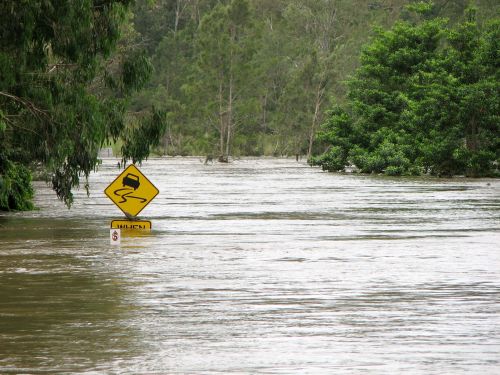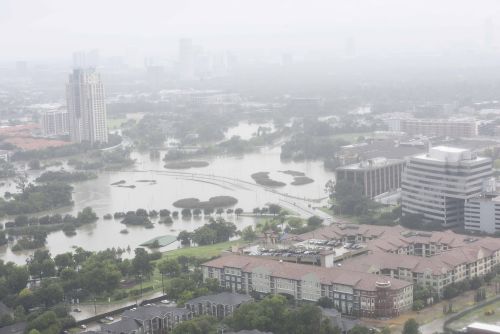Flood Insurance, Commercial Real Estate and Climate Change
Climate change is forcing the commercial real estate industry to re-think the effectiveness of flood insurance that developers, lenders and investors have relied on for decades.
Rising sea levels and more extreme weather events could push that reliance to a breaking point. In 2018, approximately US$91 billion in damages resulted from 14 weather and climate disasters in the United States alone, each with losses exceeding US$1 billion, mostly to residential and commercial real estate.
Flood insurance is one of many areas of concern that climate change is bringing to the commercial real estate finance industry.
Limitations of the National Flood Insurance Program and FEMA flood maps

Congress created the National Flood Insurance Program (NFIP) as a division of the Federal Emergency Management Agency (FEMA) in 1968. It is a federally underwritten flood insurance program intended to offset the expense of disaster relief by requiring floodplain occupants to pay premiums into an insurance pool. The program was created to fill the vacuum left by private insurers who no longer found it profitable to insure coastal and low-lying areas at a high risk of flooding.
Today, NFIP coverage is provided by roughly 60 different insurance companies and written through hundreds of licensed insurance agents across the country. As of late 2019, NFIP had approximately 5.1 million outstanding flood insurance policies in at least 22,387 communities with approximately US$1.3 trillion of flood insurance coverage.
National Flood Insurance Program is financially unstable
It is heavily subsidized by FEMA and funded year-to-year by Congress. At present, NFIP carries US$20.5 billion in debt owed to the U.S. Treasury, even after Congress cancelled US$16 billion of NFIP’s debt in 2017 to pay claims for Hurricanes Harvey, Irma and Maria. Maintaining this level of debt is unsustainable.
Many experts say NFIP is virtually insolvent and needs to be re-designed to continue to be the favored backstop to flood damage in this country. Looking at the math, this is easy to see. In 2018, NFIP only collected approximately US$3.6 billion in annual premium revenue but paid out approximately US$9.7 billion in flood insurance claims and incurred approximately US$2.6 billion of administrative expenses. One catastrophic storm can easily wipe out not only thousands of miles of low-lying real estate, but also the NFIP’s bank account. For Superstorm Sandy alone, the NFIP pay-out was in excess of US$8 billion.
Public and private efforts to combat extreme flooding

The combination of the increased frequency and severity of extreme flooding events and the structural and financial limitations of flood insurance have caused many public and private sector participants to take matters into their own hands. Many examples can be seen across the country, primarily in coastal states, cities and towns.
Actions on the municipal and state levels
In October 2019, New Jersey Governor Phil Murphy marked the seventh anniversary of Hurricane Sandy by signing Executive Order No. 89 in order to establish a statewide Climate Change Resilience Strategy. This new public initiative will develop and deliver a science-based report on climate change concerning the current and anticipated impact of climate change in New Jersey, including sea level rise and the increased frequency and severity of flooding through 2050. This report will be delivered to the governor by April 2020 and updated every two years.
Miami, Florida, in 2013 embarked on a US$600 million storm water management initiative to elevate roads and install state-of-the-art water pumps. More recently, the local government approved the “Miami Forever Bond” issuance aimed at financing various building improvements and infrastructure fortifications designed to control flooding, improve draining and protect communities.
How banks and insurance companies are preparing for increased flooding

The commercial real estate finance industry has no uniform strategy to underwrite the increased frequency and severity of flooding due to climate change.
Part of this uncertainty is driven by the reality that the flood insurance industry (both public and private) is at a crossroads of how to underwrite climate change risks effectively. Both will soon be forced to adjust to face the environmental and economic realities of a country more prone to frequent, catastrophic and repeated flooding. We believe certain key adjustments will occur to both industries in the near future.
Stricter underwriting standards among banks and lenders
Either through greater investor demand and/or new financial regulations, banks and other lending institutions are likely to employ stricter underwriting standards when making loans secured by commercial real estate located in SFHAs and other high-risk flooding areas. These more restrictive requirements will be seen first in the legal documentation that evidences both the origination and sale of commercial real estate loans. A typical loan application today will have very limited detail about flood insurance, as it is usually included in a long list of insurance coverages required by the bank. Such a clause might read as follows:
— “Receipt and approval by Lender of property, liability, rent loss, builders risk, workers compensation, terrorism, and flood insurance as well as any other insurance deemed necessary by the Lender.”
A mortgage or loan agreement will also use general language requiring a borrower to maintain the NFIP minimum flood coverage or other coverage required by the lender if the subject property is located in a SFHA. An example of this covenant often reads:
— “if the Property is now or hereinafter located in a FEMA designated “special flood hazard area”, flood insurance in an amount equal to not less than the lesser of (A) the maximum amount of such insurance available under NFIP, (B) the Loan amount, or (C) the insurable value of the Property, together with such “excess flood” insurance Lender reasonably requires.”
What to expect going forward

Superstorm Sandy provides an important warning. Climate scientists say that in the late 1800s this type of powerful storm was a once-in-500 year event for the New York City tri-state area. As of 2017, the probability was revised to be a once-in-25 year event. And by 2030, it is now predicted to be a once-in-five year event.
Looking more broadly at the U.S. as a whole, in roughly the last 10 years, there have been 17 once-in-a-1,000 year downpour events across the country. By definition, once-in-a-1,000 year flood events are supposed to happen once-in-a-1,000 years. Therefore, the occurrence of 17 such events in less than a decade makes a very obvious point.
Miami and the NYC/Newark metro areas are the number 1 and 3 geographic areas, respectively, most at risk of asset value loss from sea level rise over the next 50 years by asset value. More than US$130 billion worth of real estate in Manhattan is located in a flood zone.
Against the backdrop of these staggering figures, we must closely follow how the commercial real estate finance and flood insurance industries will adapt in the coming years, especially with the U.S. economic expansion now entering an unprecedented second decade.
Among the questions are whether the National Flood Insurance Program will be reformed, whether private flood insurers raise their rates to levels only wealthy real estate sponsors can afford, and whether banks and real estate bond buyers will call for more detailed disclosure to more accurately balance the risk of loss. The recent annual letter written by BlackRock CEO Larry Fink calling out climate risk as a serious investment risk clearly shows which way the weather vane is pointing.
We know the commercial real estate finance industry to be incredibly resilient and anticipate it will be ready to meet the challenge of more extreme flooding. From the Terrorism Risk Insurance Protection and Reauthorization Act, to the risk retention rules under the Dodd-Frank Act, the recent HVCRE regulations and the ongoing phase-out of LIBOR, the commercial real estate industry has proven time and time again that it can evolve to all types of changes to the marketplace.


